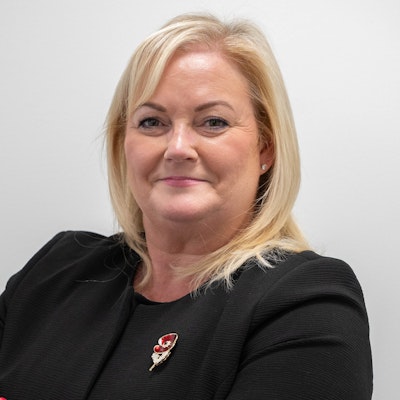
How Can Insurers Embrace and Lead with Connected Ecosystems?
On November 15, Mike Jones, Deborah Bale, and Matthew Kearney held a talk on the concept of Liquid Insurance ecosystems in the framework of the NextStep 2022 event, organized by Outsystems.
The company, a world leader in the development of high-performance applications, had NTT DATA as a Gold Sponsor; and as part of the collaboration of both companies, the Session "How Can Insurers Embrace and Lead with Connected Ecosystems?" took place.
Ecosystems offer organizations across industries and geographies an opportunity to innovate and move beyond traditional products and services that will ultimately improve the customer experience. In an economy increasingly stimulated by ecosystems, it is not the strongest organizations that will survive, but those most receptive to change.
All this and much more is summarized below and was, to a large extent, the content of this great conversation held by three of NTT DATA's executives to discuss one of the main topics of our Insurance Vision.
Main challenges faced by insurers and how they address them
Today we are seeing low margins, fractured customer and colleague experience, and real competition in the marketplace, forcing insurers to constantly rethink how to truly improve their speed to market and reduce the cost to serve. All insurers are looking for ways to accelerate their growth strategy, and technology is really the key to this.
However, most are hampered by legacy technology that is costly to maintain and cripples the talent that simply keeps the lights on. Organizations need an open, intelligent and scalable platform that leverages real-time data to always deliver a personalized customer experience.
Changes that are driving insurers to meet these challenges
Insurers have a lot of data, and when given context, it becomes really valuable information. That is the silver bullet, what contributes to that personalized customer experience that our clients and customers expect today.
The number one priority, in simple terms, is intimately understanding the customer and communicating with them. And achieving that level of hyper-personalization is only possible when insurers have enough data to drive their own intimacy with the customer.
The appetite for data has never been greater and accessing external sources has never been easier, even with all that legacy technology. We have begun to successfully connect our customer's ecosystems by implementing robust and scalable orchestration layers that enable that connectivity to the right information at the right time from the right source, not just moving and exposing that data, but intelligently manipulating it before presenting it. The result is a seamless customer experience, tailored to their needs and with the products they really want.
Another item very high on the agenda is the colleague experience. It should not be necessary to access multiple systems to gain customer insight in today's world. Employee satisfaction is something we all need to focus on; as of right now we are all facing a talent shortage. And with hybrid work eliminating location as a pre-employment barrier, everyone needs to feel really engaged and motivated in their role
So we are seeing several small changes in building all of those journeys, taking them outside of the limitations of legacy technology, whether in the integration of solutions that streamline and automate certain parts of the journey or building components that give a competitive advantage. This is what enables our clients to leapfrog their connectedness goals and be valued as insurers that offer the coverage their customers need.
But it is not just about being digital. That change has already happened, the expectation is that everything will be digital. It is really about building a relationship with the customer, presenting them with information that ensures they provide as little data as possible. That fosters intimacy and loyalty and makes it easier for them to do the mundane business of insurance while making sure we do not lose sight of the colleague experience. The company have to be as nimble as the customers themselves.
The role of the 4 Forces of Insurance Acceleration
It is really a combination of buy and build. So building insurer's competitive advantage using Outsystems to address speed to market and integration with buy-side, the emerging players within the insurance technology space are really bringing in Sass solutions that do certain parts of the insurance lifecycle and is a really dynamic way that no monolithic platform has demonstrated.
The market itself has been disrupted by these entrants, who have developed the solution to meet the challenge. And many of them have actually met those challenges by working in the industry themselves and not pretending to solve multiple areas. They actually focus on that single activity, and they do it very, very well.
We are talking about areas like pricing, which can move away from painful, outdated manual processes to really free up those highly paid actuarial and underwriting colleagues to focus on what matters, and that is building those models at full speed.
But in addition, underwriting dashboards can eliminate the manual analysis an underwriter does to collate all the information they need to assess risk, which often comes from multiple file systems and sources, as well as provide those key alerts to draw their attention to key areas of concern that do not meet the thresholds and tolerances that policies are underwritten to.
Taking advantage of these new entrants, which are not constrained by legacy architecture, allows insurers to get best-of-breed without having to rip out the core of legacy platforms, something everyone is afraid to do, something that is possible with a robust integration layer.
One thing we should keep in mind is that we need to be aware that these startups can sometimes be less mature when it comes to introducing change into large-scale organizations. So patience and a collaborative relationship are key to ensuring success in implementing their solutions, especially in heavily governed IT environments.
And all these small changes in themselves really lead to one result, and that is that connected ecosystems are the accelerator in this transformation phase that is needed.
The importance of Insurance Ecosystems in solving these challenges
The idea of a seamless customer experience in traditional industries just does not stand up to scrutiny. What needs to be done to provide a seamless experience is simply more than any single organization can deliver. So what we are seeing is an interconnected set of services, applications and technologies brought together by players from different industries to create that single integrated experience.
Just look at how the automotive sector has been transformed to become a smart mobility ecosystem. And organizations like BMW are creating new partnerships, opportunities, and innovation. The example we see here is the display around their new flow technology, which is literally using the E Ink developed for e-readers so one can change the color of their car at the touch of a button.
A testament to that, that kind of innovation and collaboration between organizations would never have happened before. It is across all industries, from agriculture to payment systems, where banks are much more concerned about the stripe than other banks are these days. So that general collapse is very much part of what's going on.
Our 2023 Insurance Vision research has really shown that this is not just something for other industries. In fact, 4/5 of insurers are already actively engaged or interested in being part of an ecosystem. The reality is that the insurer can not do it alone as an organization.
We have found out that there are four main areas of the ecosystem that insurers are participating in or want to participate in. The most important is health and healthy living. It is closely followed by smart mobility. And finally, the Home and Enterprise Shield ecosystems, both of which are smaller at the moment. We are seeing them develop rapidly over time, but the bottom line is that insurers that delay the development of their ecosystem will lose market share to more innovative competitors.
We can take a couple of examples from what Ping An is doing in China, where its online car-buying system is already generating a third of all potential customers for all its financial services business. Something similar is happening with Discovery in South Africa or Vitality in the U.K. from a health and wellness standpoint and, of course, Insure my Tesla, which has only been around for four years, simplifying that process and bringing 16 million customers to Liberty Insurance.
Tips for insurers to lead Insurance Ecosystems
It is important to recognize that the consensus around the research is that only 20% of the ecosystems that are created end up being sustainable in the long term. And an underlying ecosystem partner at maturity is a critical factor in terms of its failure. But the good news is that there are five things that we see successful insurers doing consistently well.
The first is to be very clear from a strategic intent perspective. We have identified the five key reasons for an insurer to enter into an ecosystem:
To expand their market offering in terms of access;
To strengthen the core business;
To protect themselves from other ecosystems;
To leverage revenue from adjacent lines of business;
To launch a new company to separate from the core business.
So if an insurance company does not fit neatly into one or more of these, then it needs to take a hard look at what they are doing and maybe realign.
Secondly, they really have to establish organizational capabilities. Partner management is incredibly important and it is very important to say that it does not mean renaming supplier management; supplier management is not part of management, and it is a very different mindset and skill set.
The third point is related to flexibility. The idea of being entrepreneurial in an organization is an idea that has taken off in the last five or ten years. And that is incredibly important in terms of the way people think and behave, from basic things like adopting OKRs rather than KPIs, and how to get the cross-functional team working and trust, particularly between partners, which again is something we have referred to before.
The fourth key is digital literacy, particularly for senior management, it is very important that seniors understand these things and how they fit together because otherwise, the insurance company can waste a lot of time trying to convince people, and therefore it can miss quite a lot of opportunities.
And finally, and perhaps most importantly, the supporting technology. That kind of scalable, flexible API-based architecture, which is data management analytics, is incredibly important. Because if an insurer can not quickly join, exit, or bring others into the ecosystems, then it may as well be as dead in the water. And that, in organizations that have been around for more than 10 years, which is most of them, can be a real challenge because of the burden of technological legacy and technical debt.
From our perspective, what we would say is that the ability to collaborate in an integrated and seamless way is about being able to decouple from that legacy risk complexity. And that is what paves the way for an open model between insurers and their ecosystem partners of choice.
It is incredibly important because it also lays the foundation for being able to capture and maintain that much greater volume and velocity of data that they are going to need to analyze and act on to really understand customer needs and develop intimacy and hyper-personalization.
And that is why we and the clients that we work with have found OutSystems to be such a critical component in this because it allows the insurer to extract and deliver value quickly, as well as allow existing teams to go on that journey because it is so simple and easy to use.
One of the biggest failures of transformations like this is to lose that deep understanding of the customer's business that people have because they get sidelined in their ability to understand the technology.
And we find that over 100 projects with customers all over the world with everybody from Liberty Mutual and Resolution Life, Tesco Underwriting among others has made a huge difference in terms of the composable services and automated operations and integrated user experiences an insurer can get from working with OutSystems.
And ultimately in terms of how to win the challenge is about how to create a plan around what the insurance company is trying to accomplish. The company will not be able to do everything at once. And the beauty of composable elements is that it can pick and choose which bits to look at first. But then really, the company needs to think of this as an ongoing product, and build that center of excellence around it. So, it can get that excellence and understanding within the organization. And then finally, that agile, multidisciplinary team and that ability to work across geographies and time zones is also very important.
Header photo by Joshua Sortino on Unsplash
Subscribe to Our Newsletter
Get the latest insights about Global solutions for leading insurers on your email





